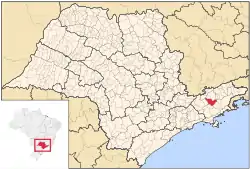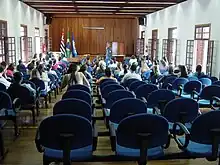Taubaté
Taubaté is a medium-sized city in the State of São Paulo, in southeastern Brazil.
Taubaté | |
|---|---|
| Municipality of Taubaté | |
.jpg.webp) | |
 Flag  Seal | |
| Nickname: Capital Nacional da Literatura Infantil | |
| Motto(s): Per aspera pro Brasilia "All sacrifice for Brazil" | |
 Location in the state of São Paulo and Brazil | |
 Taubaté Location in Brazil | |
| Coordinates: 23°01′30″S 45°33′20″W | |
| Country | |
| Region | Southeast |
| State | |
| Government | |
| • Mayor | José Antônio Saud (MDB, 2021 – 2024) |
| Area | |
| • Total | 625.00 km2 (241.31 sq mi) |
| Population (2021)[1] | |
| • Total | 320,820 |
| • Density | 510/km2 (1,300/sq mi) |
| Time zone | UTC−3 (BRT) |
| Postal code | 12000-000 |
| Area code | +55 12 |
| HDI (2010) | 0.800 – very high[2] |
| Website | taubate |
History

Taubaté was part of the ancient Tupinamba Territory, along the Paraiba do Sul River. The Tupinamba Territory in the 16th century, stretched from the Juqueriquerê River on the shores of Caraguatatuba to the Cape of Saint Thomas (Cabo de São Tomé) in the State of Rio de Janeiro. The first village was created in 1640 being proclaimed as an autonomous locality on December 5, 1645, by a pioneer named Jacques Felix. It was the first location in the Vale do Paraiba region to obtain autonomy. The locality got its current city status in 1842. By that time, it was one of the most important coffee production centers in the country, hosting the Taubaté's Agreement in 1906. In 1908, the city was made the seat of the Roman Catholic Diocese of Taubaté. In 1900 was the largest city in the interior of São Paulo.
The county name comes from the Guarani language and means village (taba) high (ybaté).
In 1891, Taubaté was one of the first cities in Brazil to industrialize with the CTI (Companhia Taubaté Industrial), a Textile Industry.
In 2012, the city gained nationwide exposure following the "Grávida de Taubaté" (pt) incident, in which local woman Maria Verônica Aparecida César Santos pretended to be pregnant with quadruplets, drawing the attention of local and national media, only for the pregnancy to be revealed as a hoax after the gestation period elapsed. The hoax was noted by globo.com as "one of the first great memes" of Brazil.[3] The woman was later diagnosed with 'fantastic pseudology' (also known as mitomania), a disorder which creates the compulsive desire to lie about a subject.[3] Since the incident, "Taubaté" has become a suffix in Brazil, in the format of "the X of Taubaté", to designate false stories or cases.[4][5]
Geography
Location
Its strategic location between the two most important Brazilian cities (São Paulo 123 kilometres (76 miles) away, and Rio de Janeiro 280 kilometres (170 miles) away), connected to both by the Presidente Dutra Highway, between high, cold mountains and the Atlantic Ocean has helped the development of the city. It is part of the Metropolitan Region of Vale do Paraíba e Litoral Norte.[6] The population is 317,915 (2020 est.) in an area of 625.00 square kilometres (241.31 square miles).[7] The city has become an industrial center, seating branches of several companies, including Volkswagen, Alstom, LG, Embraer, among many others.
A traditional city in São Paulo state, it played an important role in the historical and economic development of the country. In the gold cycle was radiating center of bandeirismo discovering gold in Minas Gerais, founding several cities. In the Second Empire, during the coffee boom of the Paraíba Valley, has emerged as the largest municipality in the state production area, hosting the Taubaté Convention in 1906.[8] The municipality contains part of the 292,000 hectares (720,000 acres) Mananciais do Rio Paraíba do Sul Environmental Protection Area, created in 1982 to protect the sources of the Paraiba do Sul river.[9]
Climate
| Taubaté | ||||||||||||||||||||||||||||||||||||||||||||||||||||||||||||
|---|---|---|---|---|---|---|---|---|---|---|---|---|---|---|---|---|---|---|---|---|---|---|---|---|---|---|---|---|---|---|---|---|---|---|---|---|---|---|---|---|---|---|---|---|---|---|---|---|---|---|---|---|---|---|---|---|---|---|---|---|
| Climate chart (explanation) | ||||||||||||||||||||||||||||||||||||||||||||||||||||||||||||
| ||||||||||||||||||||||||||||||||||||||||||||||||||||||||||||
| ||||||||||||||||||||||||||||||||||||||||||||||||||||||||||||
The climate is classified as a humid subtropical climate, under the Köppen climate classification with the average annual temperature around 69 °F (21 °C), with a maximum of 19 °C (66 °F) and a minimum of 50 °F (10 °C), with average humidity of 60% and the annual rainfalls of 55 inches (1,397 mm), the extremes temperatures recorded on the city are 33 °F (1 °C) and 100.0 °F (37.8 °C), there is also an unofficial record of −3.6 °F (−19.8 °C).
Demographics
Male: 120.288; Female: 123.819; Urban: 229.810; Rural: 14.297 (Source: Censo 2000 - IBGE)
Education and literature


Taubaté is also a university city. The University of Taubaté, UNITAU, is a municipal institution of higher learning run by the state, but also by the private initiative. Brazil, like France, is a country where state-owned universities are free and rank as the best, but UNITAU isn't free. UNITAU attracts young people from all over the country who come to study in one of its many colleges, such as Medical School, Law, Dentistry, Engineering, Business Management, and also at the Department of Architecture where several alumni have excelled and won national prizes for their work, notable the Opera Prima Award.
Monteiro Lobato, reputedly one of the most significant Portuguese-language writer of books for children, was born in Taubaté. His books have been translated into many other languages, especially Sítio do Picapau Amarelo, the first and one of the largest tomes in the series of twelve.
The unique way in which the narrative unfolds, gripping as they are for the many generations of children - and adults - who have read them, evolves in a style which can be likened to the sort of magic realism that permeates later styles of Latin American literature, and is set in rural São Paulo State where legends and myths naturally abound as the Portuguese colonial culture is fertilised by the fusion of amerindian and African cultures. The scene of his books is a fictional small farm - the Sítio do Picapau Amarelo ( loosely translated as the Yellow Woodpecker Estate) owned by the central character to all of M L's books, one Dona Benta, a cultivated widow living alone in the farmlet with her black female servant Nastácia. Dona Benta's grandchildren spend their summer holidays with her and most stories revolve around that scenario, which incidentally was inspired in M L's own property.
José Bento de Monteiro Lobato was the grandnephew of the Viscount of Tremembé, a historical figure who lived in the region of Taubaté during the second half of the 19th century, in the days when Brazil, a constitutional monarchy independent from Portugal, was an expanding economy largely dependent on its coffee plantations.
Unsurprisingly, in 06/01/10 Taubaté was granted, by the Chamber of Deputies, the title of National Capital of Children's literature.[10]
Another very important man in Taubatean and Brazilian history was Amacio Mazzaropi who was one of the pioneers in the movie industry, creating many classics that show a rural Brazil in the first half of the 20th century. Mazzaropi embodies what might be described as a rural Brazilian stereotype, the Jeca – a dude – whose emotions and sentiments are universal but which nevertheless reflect his immediate environment and culture. Mazzaropi the actor and film maker was himself epitomic of another influence in that part of the country: the son of Italian immigrants who falls in love with his new homeland, although, it must be said, none of his roles reflects this, since what Amacio endeavoured to portray at all times was the somewhat raw, idillyc and also very dainty environment of the coffee growing regions of his birthplace and their pretty cities in the lush tropical landscape.
Sports
Esporte Clube Taubaté is a football club based in the city. The main competition played by the club is the Campeonato Paulista Série A2, the second level of the São Paulo state professional football championship. Taubaté have a volleyball team, one of top 4 of Brazil.
Quality of life
Taubaté has been ranked by the UNDP (United Nations Development Programme) the 21st out of 645 cities in the State in terms of quality of life, (safety, schooling, medical and dental care, transportation facilities, low pollution levels, piped sewage and piped water reaching all houses, etc.).
Twin towns – sister cities
Taubaté is twinned with:
References
- "IBGE | Portal do IBGE | IBGE". ibge.gov.br.
- "Archived copy" (PDF). United Nations Development Programme (UNDP). Archived from the original (PDF) on July 8, 2014. Retrieved August 1, 2013.
{{cite web}}: CS1 maint: archived copy as title (link) - (staff writer) (2022-01-11). "10 anos da Grávida de Taubaté: relembre o episódio em que o país inteiro foi 'trollado'". globo.com (in Portuguese). Retrieved 2022-09-23.
- Neto, Natival Almeida Simões (2019). O padrão [[X]n de Taubaté]n no português brasileiro: um estudo sobre compostos sintagmáticos em perspectiva construcional. Revista Diadorim (Thesis). doi:10.31513/linguistica.2019.v21n2a24366 (inactive 1 August 2023).
{{cite thesis}}: CS1 maint: DOI inactive as of August 2023 (link) - "Taubaté, cidade da mentira: o que há para conhecer na terra dos memes". iG Turismo. 2021-04-01. Retrieved 2021-07-09.
- "Lei Complementar nº 1.166, de 09 de janeiro de 2012". www.al.sp.gov.br.
- Instituto Brasileiro de Geografia e Estatística
- ABREU, Maria Morgado de. Taubaté: de núcleo irradiador de bandeirismo a centro industrial e universitário do Vale do Paraíba.,2.ª edição. Aparecida: Santuário, 1991.
- Unidade de Conservação: Área de Proteção Ambiental Bacia Hidrográfica do Paraíba do Sul (in Portuguese), MMA: Ministério do Meio Ambiente, retrieved 2016-10-01
- "Câmara aprova Taubaté como capital nacional da literatura infantil - Notícias".
External links
- (in Portuguese) Official website
- (in Portuguese) Page About the city of Taubaté